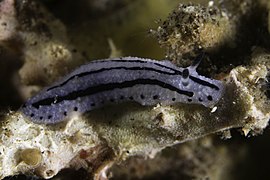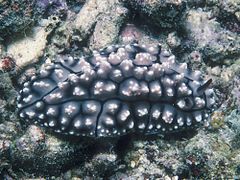Phyllidiopsis
| Phyllidiopsis | |
|---|---|

| |
| Phyllidiopsis cardinalis, head end at the bottom of the image | |
| Scientific classification | |
| Domain: | Eukaryota |
| Kingdom: | Animalia |
| Phylum: | Mollusca |
| Class: | Gastropoda |
| Order: | Nudibranchia |
| Superfamily: | Phyllidioidea |
| Family: | Phyllidiidae |
| Genus: | Phyllidiopsis Bergh, 1876 |
| Type species | |
| Phyllidiopsis cardinalis Bergh, 1876 | |
Phyllidiopsis is a genus of sea slugs, dorid nudibranchs, shell-less marine gastropod molluscs and is the largest genus within the family Phyllidiidae.[1]
Description
The species in this genus differ from the other genera in this family by possessing an elongate foregut and fused oral tentacles.[2]

Distribution
These nudibranchs can be found in the tropical Indo-Pacific region, the eastern Pacific region, in the Red Sea, in the Caribbean Sea and a few in the Northwest Atlantic Ocean. About half of the described species can be found in deep waters. Among these deep-water sea slugs, there is a group of white species, lacking all contrasting colors.[3][4]
Species
There are presently about 30 species in the genus Phyllidiopsis including :[1]
- Phyllidiopsis annae Brunckhorst, 1993[5]
- Phyllidiopsis anomala Valdés, 2001 [3]
- Phyllidiopsis bayi (Bouchet, 1983)
- Phyllidiopsis berghi Vayssière, 1902 [6]
- Phyllidiopsis blanca Gosliner & Behrens, 1988 [7]
- Phyllidiopsis boucheti Valdes & Ortea, 1996
- Phyllidiopsis brunckhorsti Valdés, 2001 [3]
- Phyllidiopsis burni Brunckhorst, 1993[5]
- Phyllidiopsis cardinalis Bergh, 1876 : type species of the genus Phyllidiopsis
- Phyllidiopsis circularis Valdés, 2001 [3]
- Phyllidiopsis crucifera Valdés, 2001 [3]
- Phyllidiopsis dautzenbergi (Vayssière, 1912)[8]
- Phyllidiopsis fissurata Brunckhorst, 1993[5]
- Phyllidiopsis futunai Valdés, 2001[3]
- Phyllidiopsis gemmata Pruvot-Fol, 1957[9]
- Phyllidiopsis holothuriana Valdés, 2001 [3]
- Phyllidiopsis krempfi Pruvot-Fol, 1957[9]
- Phyllidiopsis loricata (Bergh, 1873)
- Phyllidiopsis lozoueti Valdés, 2001 [3]
- Phyllidiopsis macrotuberculata Valdés, 2001 [3]
- Phyllidiopsis monacha (Yonow, 1986)
- Phyllidiopsis neocaledonica Valdés, 2001 [3]
- Phyllidiopsis phiphiensis Brunckhorst, 1993[5]
- Phyllidiopsis pipeki Brunckhorst, 1993[5]
- Phyllidiopsis quadrilineata (Bergh, 1905)
- Phyllidiopsis richeri Valdés, 2001[3]
- Phyllidiopsis shireenae Brunckhorst, 1990 [10]
- Phyllidiopsis sinaiensis (Yonow, 1988)[11]
- Phyllidiopsis sphingis Brunckhorst, 1993[5]
- Phyllidiopsis vanuatuensis Valdés, 2001[3]
- Phyllidiopsis xishaensis (Lin, 1983)
- Species brought into synonymy
- Phyllidiopsis carinata Eliot, 1910 : synonym of Phyllidia ocellata Cuvier, 1804
- Phyllidiopsis papilligera Bergh, 1890: synonym of Ceratophyllidia papilligera (Bergh, 1890)
- Phyllidiopsis striata Bergh, 1888: synonym of Phyllidiella striata (Bergh, 1890)
A maximum-parsimony analysis of the nucleotide sequence of the 16S mtDNA gene, performed in 2003, has shown that the genus Phyllidiopsis is paraphyletic.[12]
-
Phyllidiopsis sp. 1
References
- ^ a b Bouchet, P.; Gofas, S. (2012). Phyllidiopsis. Accessed through: World Register of Marine Species on 2012-06-07.
- ^ Brunckhorst D.J. (1993) The systematics and phylogeny of phyllidiid nudibranchs (Doridoidea). Records of the Australian Museum suppl. 16: 1-108. page(s): 18
- ^ a b c d e f g h i j k l Valdés, A. (2001). "185". Deep-water phyllidiid nudibranchs (Gastropoda: Phyllidiidae) from the tropical south-west Pacific Ocean. in : P. Bouchet & B. A. Marshall (eds.), Tropical deep-sea benthos, volume 22. Mémoires du Muséum National d’Histoire Naturelle. Vol. 22. pp. 331–368.
- ^ Valdés. Á. ( 2001). Depth-related adaptations, speciation processes and evolution of color in the genus Phyllidiopsis (Mollusca : Nudibranchia). Marine Biology 139(3):485-496.
- ^ a b c d e f Brunckhorst, D. J. (1993). The systematics and phylogeny of phyllidiid nudibranchs (Doridoidea). Records of the Australian Museum, supplement 16:1-107, pls. 1-9.
- ^ Vayssière, A. J. B. M. (1902). Opisthobranches. In: Expéditions scientifiques du “Travailleur” et du “Talisman” pendant les années 1880-1881-1882-1883, pp. 221–270, pls. 9-11. Ouvrage publié sous les auspices du ministére de l'instruction publique. ; p. 237
- ^ Gosliner, T. M., & D. W. Behrens, (1988). A review of the generic divisions within the Phyllidiidae with the description of a new species of Phyllidiopsis (Nudibranchia, Phyllidiidae) from the Pacific coast of North America. Veliger 30(3):305-314. ; p. 312
- ^ Vayssière, A., 1912. Recherches zoologiques et anatomiques sur les Opisthobranches de la Mer Rouge et du Golfe d'Aden. Part 2. Annales du Faculté des Sciences de l'Université de Marseilles, Supplement 20: 5-157.
- ^ a b Pruvot-Fol, A. (1957). Révision de la famille des Phyllidiadae. IIe Partie. Journal de Conchyliologie 97:104-135, pl. 1. ; p. 115
- ^ Brunckhorst, D.J. (1990). "Description of a new species of Phyllidiopsis Bergh (Nudibranchia: Doridoidea: Phyllidiidae) from the tropical Western Pacific, with comments on the Atlantic species". Journal of Molluscan Studies. 56 (4): 577–584. doi:10.1093/mollus/56.4.577. ISSN 1464-3766. Retrieved 2010-02-01.
- ^ Fahrner, A.; M. Schrödl (2000). "Redescription of Phyllidiopsis sinaiensis (Yonow, 1988) (Nudibranchia: Doridoidea: Phyllidiidae), with a review of the Red Sea Phyllidiidae". Journal of Molluscan Studies. 66 (4): 467–476. doi:10.1093/mollus/66.4.467. ISSN 1464-3766. Retrieved 2010-02-01.
- ^ Valdés, Angel (2003). "Preliminary molecular phylogeny of the radula-less Dorids (Gastropoda: Opisthobranchia), based on 16S MTDNA sequence data". Journal of Molluscan Studies. 69 (1): 75–80. doi:10.1093/mollus/69.1.75. ISSN 1464-3766. Retrieved 2010-02-01.
Bibliography
- Bergh, L. S. R. (1889). Malacologische Untersuchungen. In: Reisen im Archipel der Philippinen von Dr. Carl Gottfried Semper. Zweiter Theil. Wissenschaftliche Resultate. Band 2, Theil 3, Heft 16, 2 Hälfte, pp. 815–872, pls. 82-84.; p. 859
- Bergh, L. S. R. (1890). Report on the results of dredging, under the supervision of Alexander Agassiz, in the Gulf of Mexico (1877–1878), and in the Caribbean Sea (1879–1880), by the U.S. Coast Survey steamer “Blake”, Lieut.-Commander C. D. Sigsbee, U.S.N., and Commander J. R. Bartlett, U.S.N., commanding. Report on the nudibranchs. Bulletin of the Museum of Comparative Zoology, Harvard 19(3):155-181, pls. 1-3. ; p. 175
- Bergh, L. S. R. (1892). Die Nudibranchiata holohepatica porostomata. Verhandlungen der königlich-kaiserlich Zoologisch-botanischen Gesellschaft in Wien Abhandlungen) 42:1-16. ; p. 16
- Bergh, L. S. R. 1897. Opisthobranchiaten. Ergebnisse einer Forschungsreise in den Molukken und Borneo, im Aufträge der Senckenbergischen naturforshenden Gesellschaft ausgeführt von Dr. Willy Kukenthal. Abhandlungen Herausgegeben von der Senckenbergischen Naturforschenden Gesellschaft 24(1):95-130, pls. 12-13. ; p. 112
- Eliot, C. N. E. (1906). Nudibranchiata, with some remarks on the families and genera and description of a new genus, Doridomorpha, pp. 540–573, pl. 32. In: J. Stanley Gardiner (Ed.) The fauna and geography of the Maldive and Laccadive Archipelagoes, being the account of the work carried on and of the collections made by an expedition during the years 1899 and 1900, vol. 2. ; p. 563
- Marcus, Ev., & Er. Marcus. (1962). Opisthobranchs from Florida and the Virgin Islands. Bulletin of Marine Science Gulf & Caribbean 12(3):450-488. ; p. 478
- Pruvot-Fol, A. (1954). Mollusques Opisthobranches. Faune de France, Paris 58:1-460, pl. 1; p. 329
- Vayssière, A. J. B. M. (1913). Mollusques de la France et des régions voisines, tome premier, amphineures, gasteropodes opisthobranches, heteropodes, marseniades et oncidiides. Encyclopedie Scientifique, publiee sous la direction du Dr. Toulouse, Bibliotheque de Zoologie Doin, Paris, pp. 1–420, I-XII, pls. 1-37. [Nudibranchia pp. 243–365] ; p. 364
- Yonow N. (2012) Opisthobranchs from the western Indian Ocean, with descriptions of two new species and ten new records (Mollusca, Gastropoda). ZooKeys 197: 1–129. [22 May 2012].











